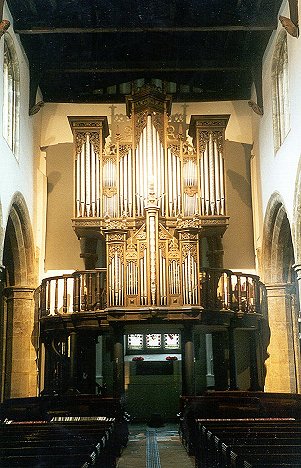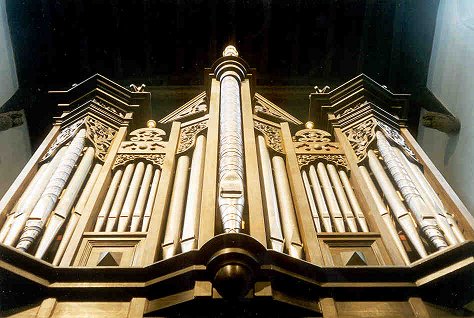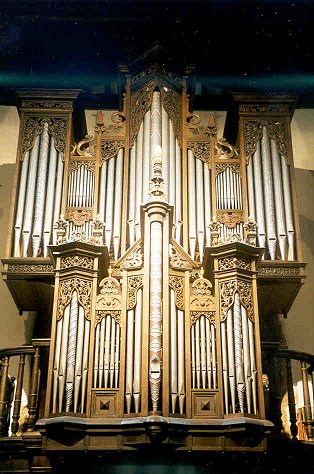Simon Fitgerald writes:
I was immediately struck by the imposing organ
with its casework and within seconds I was seated at the equally eye-pleasing
console, where the three manuals have shorter than usual keys. Whilst individual
stops are a delight to play and listen to, as the registration builds up
so the sound becomes less and less satisfactory. For example, the Open
Diapason on the Great has a very light and unforced intonation that is
beautiful; build this up to the Mixture and the result is very different.
Although not necessarily an unpleasant sound, it has lost all its beauty,
and turned mediocre. The reed is colourful and forthright, sounding rather
fine in the tenor particularly. With the Cornet (itself highly suited to
classical English repertory) an imposing and convincing Grand Jeu is formed.
Within North German repertory, this division is hampered by the hard Mixture,
which quickly tires the ear. The 8', 4' and 2' ranks in combination are
far more successful in this respect.
The Swell has similar problems to the Great
and this is due mainly to the large Mixture which has a hard, spiky sound
which is again something that soon palls.. The two unisons are delightful,
and together with the gentle Tremulant give a good approximation of undulating
strings. The reeds are the least happy members of the department. The Hautbois
is a far cry from the gentle Oboes that most of us are probably used to
- it 'fizzes' and scratches at the ear drum towards the treble. In the
bass and tenor it sounds much like a small trumpet, and is just about able
to convince in French romantics. The addition of a sub-unison reed is quite
understandable on an organ this size, but the Bass Cremona is not wholly
successful. In the bottom octave it is debatable whether it actually produces
any 16' tone at all, and further up the keyboard whilst it develops a pleasant
timbre again it is uncomfortable as a chorus reed, particularly so with
its unison counterpart. The classic Full Swell with reeds and upperwork
is one of the finest sounds an organ can produce, especially when thinking
of the numerous Willis examples left to us. Here the result is less than
satisfying - a strident mixture, scratchy unison and buzzing sub-unison
are not the best of partners!
The Choir in its chaire case has some
beautiful sounds. The chorus sparkles and literally dances at your fingertips
and the two mutations result in a clean piquant solo sound, ideal for much
of the German baroque repertory. It is somewhat thin in the tenor to really
convince in a Tierce en taille but nonetheless its pleasing tone more than
makes up for this. The Vox Humana is superb and wheedles and whines wholeheartedly
throughout its compass - nonetheless a Dulcian or Cremona would perhaps
have been more useful, and provision of this rank in the Swell enclosure
would have increased its versatility.
The Pedal organ is rather small - the Trombone
produces an exhilerating sound but can be quite overpowering. The flues
are good but a Mixture is really required to complete the chorus and afford
the division the desired independence from the manuals.


